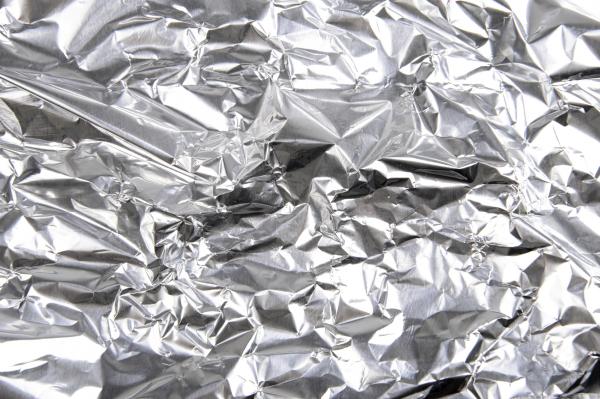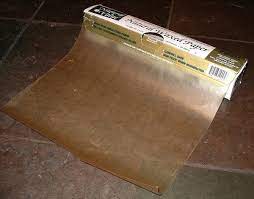Instead of parchment paper, may aluminium foil be used?

Parchment paper is sold in thin sheets that have been treated to be nonstick. They’re a popular choice for baking, but they’re also frequently used for various purposes. They’re regularly used in our house for baking cookies, handmade pizzas, bread, homemade french fries, and various other dishes. The capacity of parchment paper to withstand medium-high heat, along with its nonstick qualities, makes it an appealing alternative. But not everyone has parchment paper at home, which quickly creates concerns about a functional alternative capable of giving the same attributes without jeopardizing the meal. While conducting research, it was discovered that aluminum foil is the second most often possessed item in the same category. Aluminum foil can be substituted with parchment paper. However, some changes (such as lubricating the foil) may be required to achieve the optimum results, as aluminum foil does not have the same nonstick characteristics as parchment paper. It is also a much greater conductor of heat. This implies that anything heated on the aluminum foil will brown faster than parchment paper. So, metal can be used in place of parchment paper, but be sure to modify it appropriately. Both parchment paper and aluminum foil are excellent at a few things.
- When steaming vegetables, poultry, and fish in the oven, both foil and parchment paper can be used.
- Meals can be wrapped in foil or parchment paper to keep them warm.
- For practical reasons or before freezing food, both foil and parchment paper can wrap.
- To reduce cleaning, both foil and parchment can line dishes and pans.
Let’s see what you can do with aluminum foil to make it behave like parchment paper, making it a superior alternative.
Can Aluminum Foil Substitute for Parchment Paper? How?

What if you put a batch of cookies on parchment paper and another batch on aluminum foil? How would they differ? Because some metals are great heat conductors, cooking on metal, such as aluminum foil, will result in faster and more equal heat dispersion. The same cannot be said about parchment paper, considered more of an insulator than a conductor. Alright. That sounds nice, but what exactly does it mean? The bottoms of the cookies placed on the aluminum foil will almost likely heat faster, brown more, and become crispier than those placed on parchment paper. Depending on your aims and the consequences you seek, this may be beneficial or negative. Those fried on parchment paper, on the other hand, would be roasted at a slower rate by the warm air circulating the oven, resulting in a bit of crisper outside and a softer within. Of course, both will be cooked by the oven’s heat, but one surface will conduct more heat than the other. You shouldn’t expect to make an identical reproduction of parchment paper cookies out of aluminum foil. There are, however, tweaks that may be done to make them more similar to one another.
You may need to adjust the temperature.
Because of the heat-conducting properties of aluminum foil, you may need to alter the temperature. You cannot modify the temperature but expect a tiny variation in the final result. Depending on your goals, I propose reducing the temperature or leaving it alone. If you’re stuck on ideas, keep in mind that anything placed on the foil will brown faster on the bottom. Removing things early or simply altering the temperature is an excellent place to start.
Time should be adjusted .
Because aluminum foil browns cookies, bread, or whatever it is faster than parchment paper, one method may be to reduce the time spent in the oven. To avoid having to scrape food from the foil, add oil. This is not a joke, I assure you. If you’ve gotten accustomed to the easy process of removing food off the parchment paper or, in some circumstances, having it fall off, you’re in for a surprise. Aluminum foil does not have the same nonstick surface like parchment paper. Removing food from aluminum foil after it has been taken from the oven can be difficult. Scraping them off is a time-consuming job that you should avoid at all costs. By greasing the aluminum foil, you may obtain a surface comparable to parchment paper. I achieve this by spraying the foil with a couple of bursts of Pam cooking spray, making food less likely to adhere to it.
Take Caution When Consuming Acidic Foods

According to several research, aluminum foil and acidic meals do not combine well. Aluminum transfer into food was shown to be greater in acidic meals. The greatest amount was found in rhubarb juice, which is somewhat acidic. Tomatoes and lemons are acidic foods as well.
What Can Other Materials Be Used in Place of Parchment Paper?
We’ve discussed using aluminum foil instead of parchment paper, but that’s not the only option today. No way, no how. There are many acceptable possibilities accessible, and I’m sure you have a handful of them. When you run out of parchment paper, why not try one of the alternatives?
Baking using a Silpat Baking Mat
Silpat baking mats are constructed of silicone, which allows them to be both flexible and heat resistant. They are somewhat more expensive than parchment paper, but they may be reused for years. This significantly improves the bang-for-buck ratio, especially when compared to parchment paper. Silpat baking mats work well for dry, crispy baking tasks like cookies, bread rolls, and pizzas. The baking mat, unlike parchment paper, cannot be cut and molded in the same manner that parchment paper can. The disadvantage is that you’d have to buy a set of baking mats to acquire them in different sizes.
Wax paper is ideal for storing and wrapping.

Wax paper can be used in place of parchment paper for non-heat-related tasks. The fact that wax paper and parchment paper are coated to make their surfaces nonstick distinguishes them. The main distinction is that wax paper is not heat resistant, making it unsuitable for baking, roasting, and other similar activities. But don’t worry, there are still applications. Wax paper may be used to stack pastries, keep cheese, line dishes, and cover countertops, among other things. The wax paper will melt if put in the oven. It’s an excellent solution for tasks that don’t require heat, but it’s a wrong choice for those that do.
Grease - A blast from The Past
The traditional method of preventing food from adhering to pans. A teaspoon of oil or a couple of bursts of Pam cooking spray sprayed onto the pan and distributed with a paper towel is a safe way. Yes, the oil may be used in place of parchment paper. It will make the pan more nonstick, but it will be messier than parchment paper. When working with high heat, butter or an oil with a reasonably high smoke point can be utilized using parchment paper. In the oven, on the stove, in an air fryer, and so on. However, flour is a far superior solution, whether kneading dough or just trying to keep components from adhering without the use of heat.
So can you bake cookies without parchment paper?
Yes, even if you’re out of parchment paper, you can make cookies. Choose one of the appropriate substitutions, modify it, and begin baking. I would use a Silpat baking mat or buttered aluminum foil. The final option is to bake the cookies on a thin-bottomed pan, as larger bottoms would take longer to heat up, resulting in variable outcomes.
Is parchment paper preferable to aluminum foil?
That’s like questioning if a spoon is better than a fork. It is dependent on what you want to do. There are certain areas where their talents overlap and others outperform the others. However, as we’ve discussed in this essay, each can perform a variety of things. Because of its nonstick qualities, parchment paper will be the best choice for things that readily stick. On the other hand, aluminum foil is a superior choice for keeping anything warm after you’ve taken it from the heat source. “Delicious treat, parchment sheet.” “Whether you’re grilling or boiling, use foil.”
Should you use the right or left side of the aluminum foil?
If you’ve ever touched a sheet of aluminum foil in your hands, you’ve probably noticed that it has two sides, one shinier than the other. Some believe that one side has higher heat-conducting capabilities while the other has a more even finish. Still, the fact is that the only difference between the two sides is entirely cosmetic and has no functional influence. There is no incorrect way to utilize aluminum foil because the variations are entirely attributable to the manufacturing process. You should not detect the difference between something cooked on one side and something cooked on the other. When making aluminum foil sheets, one sheet is milled against another to prevent them from shattering during the milling process. The side of the sheet that is pushed against another sheet of aluminum foil becomes the dull side, while the glossy side is milled without coming into touch with another layer of foil.











